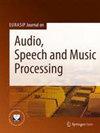Estimating the first and second derivatives of discrete audio data
IF 1.9
3区 计算机科学
Q2 ACOUSTICS
Eurasip Journal on Audio Speech and Music Processing
Pub Date : 2024-06-18
DOI:10.1186/s13636-024-00355-5
引用次数: 0
Abstract
A new method for estimating the first and second derivatives of discrete audio signals intended to achieve higher computational precision in analyzing the performance and characteristics of digital audio systems is presented. The method could find numerous applications in modeling nonlinear audio circuit systems, e.g., for audio synthesis and creating audio effects, music recognition and classification, time-frequency analysis based on nonstationary audio signal decomposition, audio steganalysis and digital audio authentication or audio feature extraction methods. The proposed algorithm employs the ordinary 7 point-stencil central-difference formulas with improvements that minimize the round-off and truncation errors. This is achieved by treating the step size of numerical differentiation as a regularization parameter, which acts as a decision threshold in all calculations. This approach requires shifting discrete audio data by fractions of the initial sample rate, which was obtained by fractional delay FIR filters designed with modified 11-term cosine-sum windows for interpolation and shifting of audio signals. The maximum relative error in estimating first and second derivatives of discrete audio signals are respectively in order of $$10^{-13}$$ and $$10^{-10}$$ over the entire audio band, which is close to double-precision floating-point accuracy for the first and better than single-precision floating-point accuracy for the second derivative estimation. Numerical testing showed that this performance of the proposed method is not influenced by the type of signal being differentiated (either stationary or nonstationary), and provides better results than other known differentiation methods, in the audio band up to 21 kHz.估计离散音频数据的第一和第二导数
本文介绍了一种估算离散音频信号一阶导数和二阶导数的新方法,目的是在分析数字音频系统的性能和特性时实现更高的计算精度。该方法可广泛应用于非线性音频电路系统建模,例如音频合成和音频效果创建、音乐识别和分类、基于非稳态音频信号分解的时频分析、音频隐写分析和数字音频认证或音频特征提取方法。所提出的算法采用普通的 7 点-模板中心差分公式,并进行了改进,最大限度地减少了舍入和截断误差。这是通过将数值微分的步长视为正则化参数来实现的,该参数在所有计算中都充当决策阈值。这种方法需要以初始采样率的分数来移位离散音频数据,而初始采样率是通过分数延迟 FIR 滤波器获得的,该滤波器采用修改过的 11 次余弦和窗设计,用于音频信号的插值和移位。在整个音频频段内,估计离散音频信号一阶导数和二阶导数的最大相对误差分别为 $$10^{-13}$ 和 $$10^{-10}$,一阶导数估计接近双精度浮点精度,二阶导数估计优于单精度浮点精度。数值测试表明,在高达 21 kHz 的音频频段内,拟议方法的这一性能不受被微分信号类型(静态或非静态)的影响,而且比其他已知微分方法的结果更好。
本文章由计算机程序翻译,如有差异,请以英文原文为准。
求助全文
约1分钟内获得全文
求助全文
来源期刊

Eurasip Journal on Audio Speech and Music Processing
ACOUSTICS-ENGINEERING, ELECTRICAL & ELECTRONIC
CiteScore
4.10
自引率
4.20%
发文量
0
审稿时长
12 months
期刊介绍:
The aim of “EURASIP Journal on Audio, Speech, and Music Processing” is to bring together researchers, scientists and engineers working on the theory and applications of the processing of various audio signals, with a specific focus on speech and music. EURASIP Journal on Audio, Speech, and Music Processing will be an interdisciplinary journal for the dissemination of all basic and applied aspects of speech communication and audio processes.
 求助内容:
求助内容: 应助结果提醒方式:
应助结果提醒方式:


